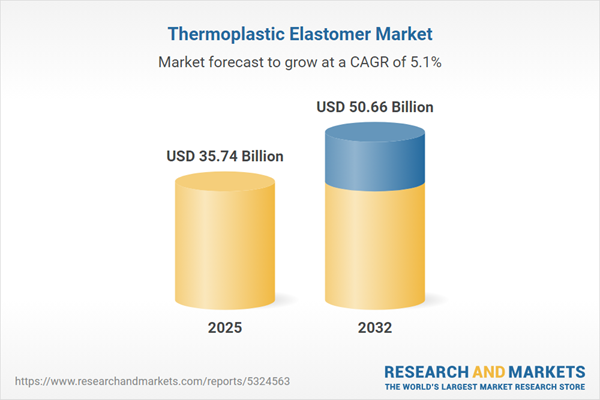Speak directly to the analyst to clarify any post sales queries you may have.
The thermoplastic elastomer market is undergoing pivotal transformation as global industries intensify their focus on performance, efficiency, and compliance. Senior leaders can leverage this in-depth analysis to navigate technological shifts and regulatory requirements shaping future growth and competitive dynamics.
Market Snapshot: Thermoplastic Elastomer Market Size and Growth
The Thermoplastic Elastomer Market grew from USD 34.10 billion in 2024 to USD 35.74 billion in 2025. It is expected to continue growing at a CAGR of 5.07%, reaching USD 50.66 billion by 2032.
Scope & Segmentation
- Product Types: Copolyester elastomers, styrenic block copolymers, styrene butadiene styrene, styrene isoprene styrene, thermoplastic polyurethanes—including polycaprolactone-based, polyester-based, and polyether-based TPU—and thermoplastic vulcanizates.
- Manufacturing Processes: 3D printing, blow molding, calendering, extrusion, injection molding.
- Form: Films, pellets, powders, sheets.
- Applications: Adhesives and sealants, automotive (including exterior, interior, and powertrain systems), building and construction, electronics, footwear, medical devices, packaging (flexible films, rigid containers), wires and cables.
- Distribution Channels: Offline sales (direct and distributors), online sales.
- Regional Coverage: Americas (United States, Canada, Mexico, Brazil, Argentina, Chile, Colombia, Peru), Europe, Middle East & Africa (United Kingdom, Germany, France, Russia, Italy, Spain, Netherlands, Sweden, Poland, Switzerland, United Arab Emirates, Saudi Arabia, Qatar, Turkey, Israel, South Africa, Nigeria, Egypt, Kenya), and Asia-Pacific (China, India, Japan, Australia, South Korea, Indonesia, Thailand, Malaysia, Singapore, Taiwan).
- Key Companies: Arkema S.A., Asahi Kasei Corporation, Aurora Plastics, LLC, Avient Corporation, BASF SE, Biesterfeld AG, Celanese Corporation, China Petroleum & Chemical Corporation, Covestro AG, Omya International AG, DuPont de Nemours, Inc., Elastron Kimya Sanayi ve Ticaret A.Ş., Evonik Industries AG, Exxon Mobil Corporation, Huntsman International LLC, KRAIBURG TPE, Kraton Corporation by DL Chemical Co., Ltd., LCY Chemical Corp., Lubrizol Corporation, LyondellBasell Industries N.V., Mitsubishi Chemical Holdings Corporation, Mitsui Chemicals, Inc., Moriroku Chemicals Company, Ltd., RTP Company, Shin-Etsu Polymer Co., Ltd., SIBUR International GmbH, Teknor Apex Company, Inc., The Dow Chemical Company, TSRC Corporation, Zeon Corporation.
Key Takeaways
- Thermoplastic elastomers offer manufacturers the flexibility to enhance production efficiency while meeting evolving durability and environmental requirements.
- Material advancements now enable superior performance in challenging environments, supporting applications across diverse sectors such as automotive, medical, and construction.
- Innovations in manufacturing—including additive processes and closed-loop recycling—are streamlining operations and addressing resource sustainability.
- Companies are deepening collaborations along the supply chain, enabling co-development and faster scale-up of specialized compounds tailored to industry needs.
- Regional differences in regulation and industrial development present varied opportunities and risk profiles, emphasizing the importance of localized strategies.
United States Tariff Impact on Supply Chains
With the onset of new United States tariffs in 2025, global supply chains for thermoplastic elastomers have experienced cost pressures. Manufacturers are actively diversifying sourcing and production footprints, leveraging procurement innovation and inventory models to sustain resilience. Collaborative agreements between producers and fabricators are now central to mitigating tariff-related risks and optimizing trade flows.
Future-Ready Strategies for Market Leadership
- Invest in next-generation research and development to advance sustainable feedstock and increase recyclability of thermoplastic elastomers.
- Foster partnerships with polymer chemists and additive technology providers to accelerate eco-friendly product introductions.
- Diversify supplier networks across multiple regions to enhance resilience to geopolitical or trade-related disruptions.
- Embed digital technologies such as predictive analytics to improve operational yield and cost management.
- Engage in co-creation initiatives with OEMs across automotive, electronics, and medical sectors to address rapidly evolving customer specifications.
- Adopt circular economy models, converting end-of-life materials into feedstock and minimizing environmental impact.
Methodology & Data Sources
This analysis draws from extensive secondary data—including industry reports, academic research, and regulatory filings—combined with primary interviews involving senior executives, product engineers, and procurement leaders. A triangulation approach validates findings, while in-depth case studies and scenario analyses offer actionable insights for stakeholders.
Why This Report Matters
- Delivers actionable benchmarks to support investment, R&D prioritization, and go-to-market strategies in the thermoplastic elastomer segment.
- Helps senior executives assess risk and opportunity across emerging regulatory environments and shifting global supply chains.
- Identifies high-impact innovation pathways and collaborative strategies for material development and supply chain optimization.
Conclusion
Senior leaders who align innovation, operational agility, and sustainability objectives within the thermoplastic elastomer industry will capture future opportunities. This analysis provides the clarity required to drive growth, optimize strategies, and ensure long-term resilience in a dynamic global market.
Additional Product Information:
- Purchase of this report includes 1 year online access with quarterly updates.
- This report can be updated on request. Please contact our Customer Experience team using the Ask a Question widget on our website.
Table of Contents
3. Executive Summary
4. Market Overview
7. Cumulative Impact of Artificial Intelligence 2025
List of Figures
Samples

LOADING...
Companies Mentioned
The key companies profiled in this Thermoplastic Elastomer market report include:- Arkema S.A.
- Asahi Kasei Corporation
- Aurora Plastics, LLC
- Avient Corporation
- BASF SE
- Biesterfeld AG
- Celanese Corporation
- China Petroleum & Chemical Corporation
- Covestro AG
- Omya International AG
- DuPont de Nemours, Inc.
- Elastron Kimya Sanayi ve Ticaret A.Ş.
- Evonik Industries AG
- ExxonMobil Corporation
- Huntsman International LLC
- KRAIBURG TPE
- Kraton Corporation by DL Chemical Co., Ltd.
- LCY Chemical Corp.
- Lubrizol Corporation
- LyondellBasell Industries N.V.
- Mitsubishi Chemical Holdings Corporation
- Mitsui Chemicals, Inc.
- Moriroku Chemicals Company, Ltd.
- RTP Company
- Shin-Etsu Polymer Co., Ltd.
- SIBUR International GmbH
- Teknor Apex Company, Inc.
- The Dow Chemical Company
- TSRC Corporation
- Zeon Corporation
Table Information
| Report Attribute | Details |
|---|---|
| No. of Pages | 184 |
| Published | October 2025 |
| Forecast Period | 2025 - 2032 |
| Estimated Market Value ( USD | $ 35.74 Billion |
| Forecasted Market Value ( USD | $ 50.66 Billion |
| Compound Annual Growth Rate | 5.0% |
| Regions Covered | Global |
| No. of Companies Mentioned | 31 |









